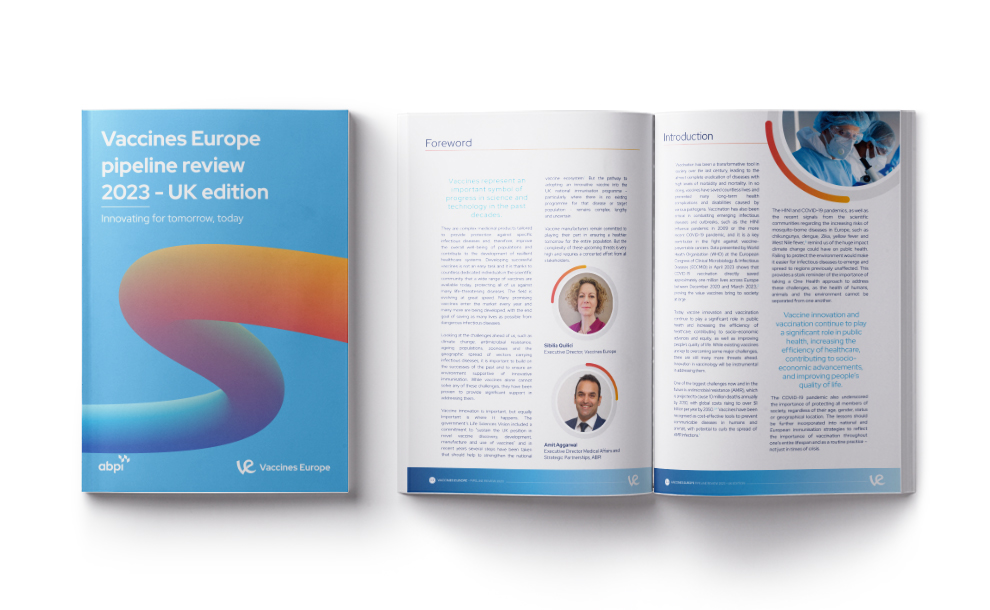103 vaccines [1] are in development for the prevention or treatment of disease.
The future of vaccines
Sustained investment in and effective introduction of new vaccines are essential to enable vaccine-preventable diseases to be controlled, eliminated and potentially eradicated.

Vaccines Europe pipeline review 2023 - UK edition
The 2023 Vaccines Europe pipeline review presents the research trends of its 15-member companies.
1. Pharmaceutical companies are innovating for the next generation of vaccines

2. Innovation could improve the simplicity and efficiency of vaccine delivery
In their research and development, pharmaceutical companies aren’t just looking at new vaccines for diseases, but also looking at ways to make vaccines more effective and easier to use. That’s especially important for infectious diseases impacting parts of the world without developed health care systems.
That research includes:
- Reducing the need for multiple doses of a vaccine by boosting the body’s immune response3
- Improving manufacturing processes to deliver vaccine doses more quickly1
- Making transportation and storage of vaccines easier to reduce wastage and improve access for hard to reach communities1
3. New technologies are helping us develop future vaccines
Advances in our understanding of disease and leaps forward in science and technology are helping us design more effective vaccines, ones with a better immune response or vaccines that can be easier or quicker to manufacture.
On the cutting-edge of vaccines development, researchers are looking at
Live-Attenuated Viruses (LAVs)
LAVs are vaccines which still contain a weakened ‘live’ virus and can cause a strong response from the immune system – nearly as good as if the person has been infected with the real virus.
Since LAVs are still live, there is a degree of unpredictability which can cause some safety and stability concerns e.g. the potential to cause disease in immune-compromised individuals (HIV) or the potential to become virulent (wake up), infect the person and able to pass on.
Nucleic acid-based vaccines
Nucleic acid-based vaccines are a new development. Cells are injected with a genetically engineered ‘plasmid’ – a bit of DNA that is separate to the cells’ own chromosomes which can replicate independently – which contains an antigen to cause an immune response.
That means the cell produces the antibody for an effective immune response. DNA vaccines have potential advantages over conventional vaccines, including the ability to induce a wider range of immune response types.
Currently no DNA vaccines have been approved for human use. Research is investigating the approach for viral, bacterial and parasitic diseases in humans, as well as for several cancers.
mRNA vaccines
RNA vaccines work by introducing an mRNA sequence (the molecule which tells cells what proteins to build) which is coded for a disease specific antigen; once produced within the body, the antigen is recognised by the immune system, preparing it to fight the real thing.
RNA vaccines are faster and cheaper to produce than traditional vaccines, and an RNA-based vaccine is also safer for the patient, as they are not produced using infectious elements. Two forms of mRNA vaccines have been developed:
conventional mRNA vaccines – The simplest type of RNA vaccine, an mRNA strand is packaged and delivered to the body, where it is taken up by the body’s cells to make the antigen.
self-amplifying mRNA vaccines – The pathogen-mRNA strand is packaged with additional RNA strands that ensure it will be copied once the vaccine is inside a cell. This means that greater quantities of the antigen are made from a smaller amount of vaccine, helping to ensure a more robust immune response.
Recombinant DNA platforms
Recombinant DNA platforms produce an exact genetic match to proteins of a virus. The protein’s DNA will be combined with DNA from a virus harmless to humans, and once injected, will rapidly produce large quantities of antigen which stimulate the immune system to protect against the virus
Virus-Like Particle (VLP) based vaccines
Virus-like particles (VLPs) are molecules that closely resemble viruses but are non-infectious because they contain no viral genetic material. VLPs contain repetitive, high density displays of viral surface proteins that present ‘conformational viral epitopes’ – the part that causes an immune response.
Non-replicating Viral Vectors
Viral vectors are tools commonly used to deliver genetic material into cells. A viral vector vaccine induces expression of pathogen proteins within host cells similarly to other attenuated vaccines. However, since viral vector vaccines contain only a small fraction of pathogen genes, they are much safer and infection by the pathogen is impossible.
Recombinant Nanoparticles
Recombinant DNA is artificially created DNA. These types of vaccines use genetically engineered three-dimensional nanostructures that incorporate recombinant proteins critical to disease pathogenesis (the biological process that allows it to happen). In short, they support production of the antigens that cause an immune response.
Peptide vaccines
Synthetic proteins that mimic naturally occurring proteins from viruses, causing an immune response.
- Adjuvant technology – this boosts the immune system’s response to a vaccine, improving its efficacy and giving the potential for vaccines to be developed that are longer lasting and more effective in older populations
- Bioconjugation technology – developments in the process of joining a protein to an antigen could increase vaccines effectiveness
References and further links
1 Vaccines Europe pipeline review 2023, UK edition (ABPI, 2024)
2 What does the future of vaccination hold? (Australian Academy of Science, Apr 2020)
Related content in this section:
Last modified: 20 March 2025
Last reviewed: 20 March 2025